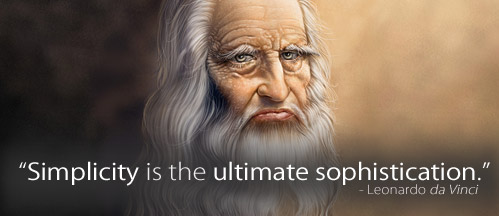Simplicity is the ultimate sophistication.
More often then not we have the tendency to complicate rather then simplify. We assume that sophistication equals results, brilliance, performance, and intelligence but it doesn’t. More information, more choices, and more products is not better. In fact it is the exact opposite more is actually less and can cause your audience to disengage. “Simplicity is the ultimate sophistication.”
In the book Paradox of Choice, Schwatz did a study that showed when presented with many choices consumers would often times become paralyzed. “Many of us labor under the impression that providing customers with a wide selection of products of a certain type increases customer satisfaction. After all, we think, if we provide them with 200 brands of peanut butter, they are more likely to find a brand that suits their taste. Schwatz cites surveys done in supermarkets that showed the reverse. When customers were presented with a huge selection of brands of a certain item, fewer customers bought the item than when fewer brands were displayed. The wide selection led to a paralysis of choice – the customers could not decide which brand to choose. As a result, they went away without choosing any.
Take this study and move it over to presentations, business plans, and teaching. Too much information can cause confusion and misunderstanding. The audience might forget or miss your point entirely because you have over complicated everything. Here is a simple solution:
Start with the main idea first and build everything around it.
Take a look at this article. The main thing I wanted the audience to get is: We tend to complicate rather than simplify. I want the audience to simplify their presentations, business plans, websites, mission statements, and scripts thus increasing their results. Everything else I write will either build on that point or prove why that point is true.
If you need a video visit ydraw.com
